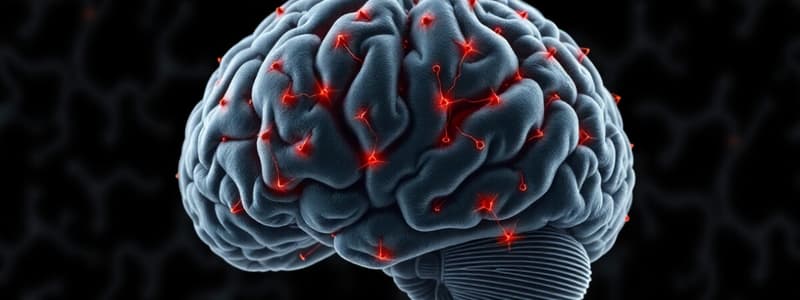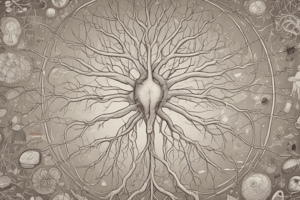Podcast
Questions and Answers
What type of neurons primarily provide input to the deep cerebellar nuclei?
What type of neurons primarily provide input to the deep cerebellar nuclei?
- Excitatory neurons
- GABAergic neurons (correct)
- Dopaminergic neurons
- Pyramidal neurons
Which deep cerebellar nucleus is involved in planning, initiation, and execution of complex movements?
Which deep cerebellar nucleus is involved in planning, initiation, and execution of complex movements?
- Interposed nuclei
- Emboliform nucleus
- Fastigial nucleus
- Dentate nucleus (correct)
What is the primary role of the interposed nuclei in motor control?
What is the primary role of the interposed nuclei in motor control?
- Balance and posture
- Coordination of eye movements
- Adjusting ongoing movements (correct)
- Motor command initiation
Damage to the deep cerebellar nuclei can result in what kind of disturbances?
Damage to the deep cerebellar nuclei can result in what kind of disturbances?
Which of the following deep cerebellar nuclei is primarily responsible for postural adjustments and balance?
Which of the following deep cerebellar nuclei is primarily responsible for postural adjustments and balance?
What is the primary function of the cerebellar cortex?
What is the primary function of the cerebellar cortex?
Which layer of the cerebellar cortex primarily contains Purkinje cells?
Which layer of the cerebellar cortex primarily contains Purkinje cells?
Which type of fiber directly connects to Purkinje cells and is important for motor learning?
Which type of fiber directly connects to Purkinje cells and is important for motor learning?
What does the arbor vitae primarily consist of?
What does the arbor vitae primarily consist of?
The deep cerebellar nuclei serve what primary role within the cerebellum?
The deep cerebellar nuclei serve what primary role within the cerebellum?
Which layer of the cerebellar cortex has fewer neurons and includes parallel fibers?
Which layer of the cerebellar cortex has fewer neurons and includes parallel fibers?
What is the primary function of mossy fibers in the cerebellar cortex?
What is the primary function of mossy fibers in the cerebellar cortex?
What role does the arbor vitae play in the cerebellum?
What role does the arbor vitae play in the cerebellum?
Flashcards
Deep cerebellar nuclei
Deep cerebellar nuclei
Brain structures that coordinate movements, receiving input from Purkinje neurons and influencing motor commands.
Dentate nucleus function
Dentate nucleus function
Crucial for planning, initiating, and executing complex movements.
Interposed nuclei function
Interposed nuclei function
Adjust ongoing movements.
Fastigial nucleus function
Fastigial nucleus function
Signup and view all the flashcards
Purkinje cells
Purkinje cells
Signup and view all the flashcards
Cerebellar Cortex Layers
Cerebellar Cortex Layers
Signup and view all the flashcards
Granular Layer
Granular Layer
Signup and view all the flashcards
Parallel Fibers
Parallel Fibers
Signup and view all the flashcards
Arbor Vitae
Arbor Vitae
Signup and view all the flashcards
Cerebellar Motor Control
Cerebellar Motor Control
Signup and view all the flashcards
Mossy Fibers
Mossy Fibers
Signup and view all the flashcards
Study Notes
Cerebellar Cortex
- The cerebellar cortex is the outermost layer of the cerebellum, primarily composed of organized neuronal layers.
- It's crucial for movement coordination, fine-tuning motor actions, and maintaining equilibrium.
- It contains three distinct layers: molecular, Purkinje cell, and granular layers.
- The molecular layer, superficial, has fewer neurons (stellate, basket cells), and parallel fibers.
- Purkinje cells are large, densely packed neurons in the intermediate layer, projecting axons to deep cerebellar nuclei.
- The granular layer, innermost, is densely packed with small granule cells, the majority of cerebellar neurons. Granule cells transmit information to Purkinje cells, forming intricate neural circuits.
- Parallel fibers are granule cell axons, horizontally traversing the molecular layer to synapse with Purkinje cells.
- The cerebellar cortex receives input from the cerebral cortex via mossy and climbing fibers.
- Mossy fibers connect to granule cells, relaying less specific information.
- Climbing fibers directly connect to Purkinje cells, crucial for motor command learning and adjustment.
- Input and integration within the cerebellar cortex are vital for motor learning and adjustment.
Arbor Vitae
- The arbor vitae ("tree of life") is a cerebellum's white matter structure.
- It's composed of branching myelinated axons, resembling a tree.
- These axons connect cerebellum parts and form communication pathways between the cerebellar cortex and deep cerebellar nuclei.
- The white matter tracts in the arbor vitae play vital roles in signal transmission between cerebellar regions.
- It coordinates motor signals and is essential for movement timing and coordination.
- The arbor vitae is crucial for information processing within the cerebellum.
Deep Cerebellar Nuclei
- Deep cerebellar nuclei are groups of neuronal cell bodies deep within the cerebellum.
- These nuclei primarily relay information from the cerebellar cortex to the central nervous system, especially the cerebral cortex.
- The deep cerebellar nuclei are critical for movement coordination and numerous motor control functions.
- They receive input mainly from Purkinje cells, GABAergic neurons in the cerebellar cortex.
- Output from the deep nuclei influences motor commands from higher brain centers.
- Damage to these nuclei impacts motor coordination, causing various motor disturbances.
- Specific deep cerebellar nuclei include:
- Dentate nucleus: vital for complex movement planning, initiation, and execution.
- Interposed nuclei (embodied by emboliform and globose nuclei): involved in adjusting ongoing movements.
- Fastigial nucleus: involved in postural adjustments and balance.
- These nuclei collectively contribute to various aspects of motor control and coordination.
Studying That Suits You
Use AI to generate personalized quizzes and flashcards to suit your learning preferences.




